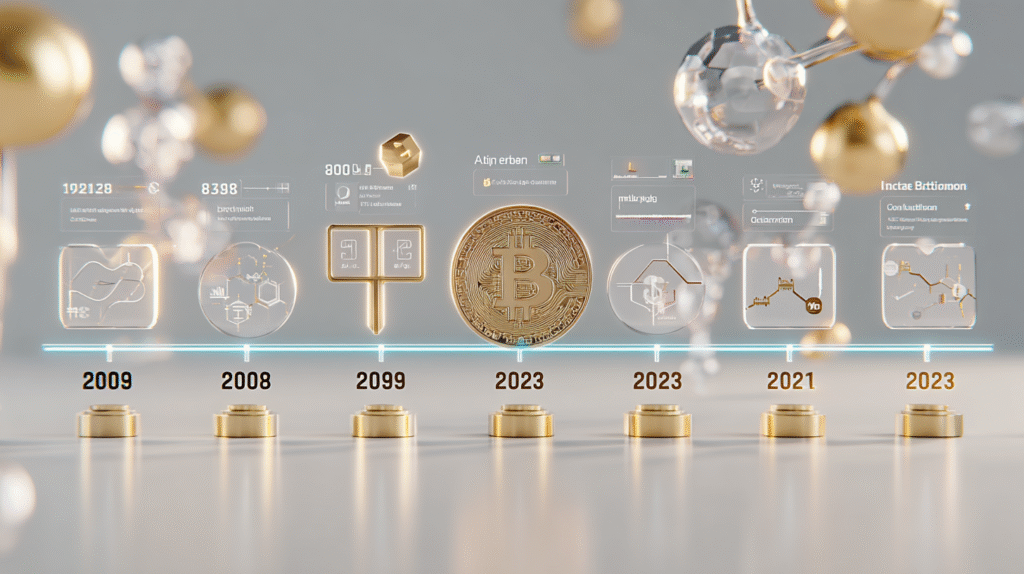History of Bitcoin: From Genesis Block to Global Adoption
Bitcoin is the world’s first cryptocurrency and remains the most influential digital asset ever created. Its history is a fascinating journey of innovation, controversy, and global adoption. This article explores the timeline of Bitcoin’s development, from the Genesis Block in 2009 to its role in today’s financial markets.
For beginners, we recommend first reading Introduction to Crypto and Crypto Trading for Beginners to understand the basics of blockchain and crypto trading before diving into history.

1. The Genesis Block (2009)
Bitcoin was launched in January 2009 by the pseudonymous creator Satoshi Nakamoto. The first-ever block of the Bitcoin blockchain is known as the Genesis Block or Block 0. Embedded in its code was a message: “The Times 03/Jan/2009 Chancellor on brink of second bailout for banks.”
This message symbolized Bitcoin’s purpose — a decentralized alternative to traditional banking systems after the global financial crisis of 2008.
2. The Early Days of Bitcoin
In its early years, Bitcoin was mostly used by tech enthusiasts and cryptography communities. The first real-world Bitcoin transaction took place in May 2010 when Laszlo Hanyecz famously paid 10,000 BTC for two pizzas — now celebrated as Bitcoin Pizza Day.
During this period, Bitcoin had little value, often trading for less than $1.
3. First Bull Run & Media Attention (2013)
By 2013, Bitcoin broke the $1,000 mark for the first time. This surge brought mainstream media attention but also highlighted risks, with incidents like the collapse of the Mt. Gox exchange in 2014, where 850,000 BTC were lost.
4. Mainstream Recognition (2017)
The year 2017 marked Bitcoin’s true arrival into mainstream consciousness. Prices skyrocketed to nearly $20,000 in December, fueled by retail investors worldwide. Bitcoin was now recognized as “digital gold.”
5. Institutional Adoption (2020–2021)
Institutional interest in Bitcoin grew significantly during the COVID-19 pandemic. Companies like MicroStrategy and Tesla added Bitcoin to their balance sheets, while PayPal integrated crypto payments. The bull run pushed Bitcoin to over $60,000 in 2021.
6. The ETF Era & Beyond (2024–2025)
In 2024, the approval of the first U.S. spot Bitcoin ETFs marked a historic milestone. Billions of dollars flowed into crypto markets, cementing Bitcoin’s position in global finance. By 2025, Bitcoin was not only an investment asset but also a foundation for decentralized finance and global payment systems.
7. The Global Impact of Bitcoin
- Financial inclusion: Providing banking access to the unbanked.
- Store of value: Digital gold against inflation.
- Innovation driver: Inspired thousands of cryptocurrencies and blockchain projects.
8. The Future of Bitcoin
The future of Bitcoin remains a hot debate. Will it become a mainstream currency, a store of value like gold, or a backbone for DeFi and smart contracts? While uncertain, Bitcoin’s resilience over the last decade suggests it will remain central to the digital asset revolution.
9. FAQ: History of Bitcoin
Who created Bitcoin?
Bitcoin was created by the pseudonymous Satoshi Nakamoto in 2009.
What was the first Bitcoin transaction?
In May 2010, 10,000 BTC were used to buy two pizzas.
When did Bitcoin first hit $1,000?
Bitcoin first crossed $1,000 in 2013.
Why is Bitcoin called “digital gold”?
Because it shares characteristics with gold — scarcity, durability, and value storage — but exists digitally.
